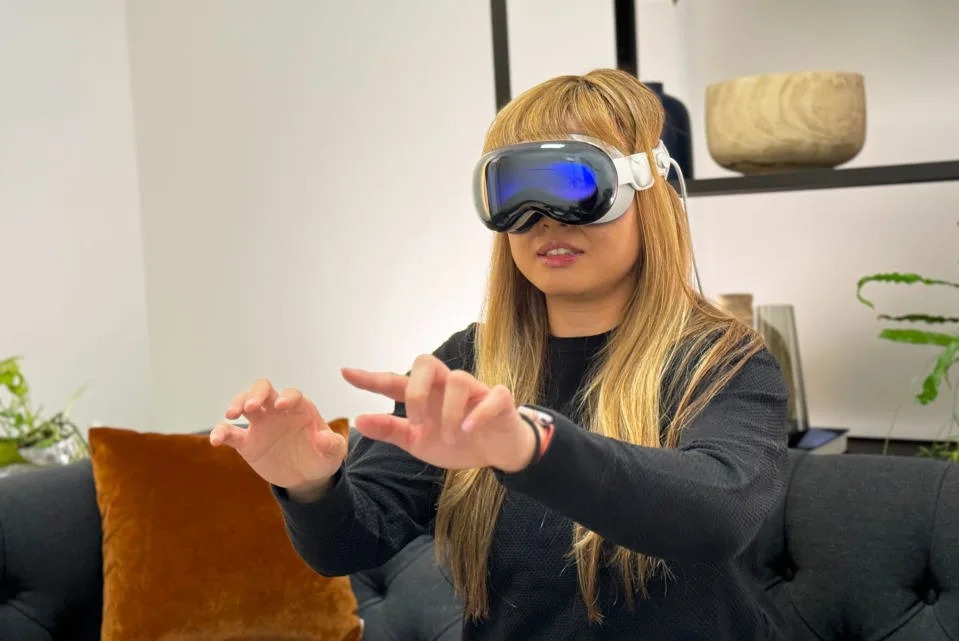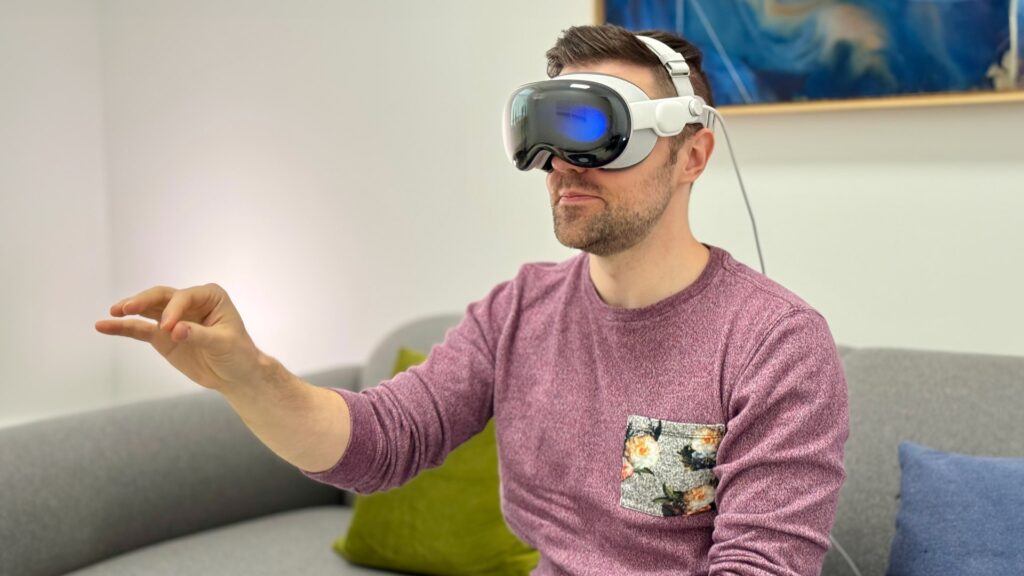When Apple CEO Tim Cook unveiled the company’s inaugural augmented and virtual reality headset, the Vision Pro, at January’s Worldwide Developers Conference, he made bold claims about it ushering in “the next generation of revolutionary technology.”
The slick device boasting high-resolution displays, advanced sensors, and powerful on-board processing immediately drew buzz. But is it truly an industry game-changer as Apple hopes? Or is the Vision Pro more sizzle than steak?
Tech experts and analysts weigh in below on whether the Vision Pro’s potentially paradigm-shifting features live up to hype – or if concerns around pricing and real-world functionality temper its impact.

The Vision Pro’s Standout Capabilities
On a technical specifications level, the Vision Pro aims to leapfrog current consumer VR and AR devices.
Unparalleled Visual Fidelity
Dual high-resolution micro-OLED 4K displays running at up to 90Hz provide unprecedented visual clarity, encompassing peripheral vision through specialized optics.
For context, this resolution and refresh rate surpasses even the Valve Index VR headset viewed as the gold standard among existing options.
Fluid Interactions Via Advanced Input Systems
The ability to interact seamlessly with virtual objects is key for immersive mixed reality. The Vision Pro brings unique capabilities to the table.
It eschews hand controllers, instead using multiple cameras to enable controller-free hand tracking with sub-millimeter accuracy. Sophisticated eye tracking also allows foveated rendering for sharper visual focus.
Powerful Onboard Processing
Past headsets relied on being tethered to PCs or game consoles. The Vision Pro packs custom Apple silicon combining CPU, GPU and neural processing capabilities for sizable computational power directly onboard.
This allows real-time spatial mapping and occlusion plus advanced analytics without offloading to external hardware.
Apple Vision Pro Early Impressions: A Glimpse into the Future?
Initial demos and hands-on evaluation by experts provide glimpse into the Vision Pro’s disruptive potential.
“It Changes Everything Users Expect”
Longtime industry analyst Anshel Sag tested the Vision Pro and says the visual fidelity hits immediately making existing devices seem antiquated. He adds that intricate hand tracking and occlusion “ushers mixed reality closer to the seamless mainstream experience Apple hopes will appeal to the masses.”
“A Nearly Magical Demo”
Veteran AR/VR designer Iskander Utebayev tried multiple demos and says the lack of controllers combined with flawless hand tracking immediately felt freeing and intuitive. He notes occlusion support and real-time environment meshing noticeably reduce vertigo. Utebayev says it felt like using “technology indistinguishable from magic” at points.
A Glimpse Into the Metaverse Future
Industry thought leader Cathy Hackl highlights the system-level integration of hardware and software coming together for seamless user experiences not possible on existing devices. She specifically singles out shared multiplayer demos powered by the headset’s processing showcasing high social presence.
Hackl concludes saying extended testing shows the Vision Pro provides “the first functional glimpse into the next era of computing – the true consumer metaverse.”
Concerns Around the Vision Pro’s Eventual Real World Impact
However beyond impressive demos, there are also countervailing takes arguing the Vision Pro might not ultimately move the needle due to certain limitations.
Astronomical Price Likely Limits Addressable Market
Priced at $3,500, many analysts worry the sticker shock could inhibit mass consumer adoption in the near term. While early adopters and enterprise usage provide revenue opportunities, scaled growth is contingent on affordability.
Mobile AR developer Mike Alger summarizes concerns arguing that “irrespective of technical excellence, high pricing clouds mainstream impact potential in the next three to five years.”

Immersive Content Library Appears Sparse – For Now
Hardware capabilities are only half the equation. Compelling software experiences ultimately compel user engagement and retention.
Some testers noted that while Apple highlighted intriguing demos, current bundled apps seem relatively sparse. The onus now falls on developers to build an expansive, engaging library across gaming, social, creative and productivity domains.
Until that ramp occurs, initial hardware sales could falter after early adopter demand saturates.
Unique Data Privacy Considerations
The Vision Pro’s advanced sensor array does intensive real-time mapping of environments and user actions. This raises questions around data usage transparency, storage policies and establishing appropriate access controls.
Industry observers urge Apple to detail strong personal data handling safeguards upfront to assuage inevitable user privacy and security concerns around mixed reality hardware.
Key Factors That Will Determine the Vision Pro’s Long Term Success
While the initial technology showcase seems promising and future focused, there are pivotal areas Apple needs to deliver on over the next year to truly catalyze paradigm shifts in how we interact with computing.
Driving Down Costs to Penetrate the Mass Market
Like most first generation hardware, inflated pricing restricts accessibility. Just as iPhone grew dominant through iterative cost cuts and pricing tier options, Apple needs a pathway to make Vision Pro attainable for average consumers to spur adoption.
Incentivizing Developer Engagement
Robust third party app ecosystems greatly amplified iOS and App Store success. Apple needs strong developer incentives and solid SDKs to quickly expand the mixed reality app selection beyond first party offerings.
Nailing use cases beyond games like business applications also expands revenue opportunities while demonstrating real world practicality.
Firm Stances on Privacy and Responsible Data Usage
Proactively addressing data privacy and security concerns related to collecting sensitive user environment and biometric data should become a priority. Forthright privacy protection principles can assure hesitant consumers while differentiating strengths against competitors.
Final Verdict: Potential to Push the Envelope – But Mileage May Vary
The Vision Pro undoubtedly establishes advanced augmented and virtual reality capabilities not seen in modern devices. Early hands-on impressions validate that Apple has the technical competency to deliver on Tim Cook’s promises to yet again revolutionize human-computer interaction models.
However, forecasts of it changing consumer technology paradigms in the vein of the original iPhone’s industry upending impact seem decidedly premature when factoring in current ecosystem and accessibility deficiencies.
If Apple can build upon the Vision Pro’s strengths by driving down costs, incentivizing developers, and establishing strong user data safeguards – the foundations become possible for the headset to ascend nearer its purported promise over the next few product cycles.










Add Comment